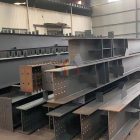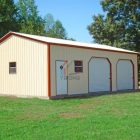What are the processing techniques of steel structure beams?
Structural steel beams are common structural elements in buildings, used to support important parts such as floors and roofs. It has the characteristics of high strength, durability and reliability, so it has been widely used in construction projects. The processing technology of steel structure beam is the key link to ensure its quality and safety. The processing technology of the steel structure beams will be introduced below.
First of all, before the processing of steel structure beams, the raw materials need to be inspected and classified. The raw materials are mainly composed of steel plates, steel pipes, etc., and their quality directly affects the strength and stability of the beam. Therefore, raw materials need to be inspected in terms of size, surface quality, material composition, etc. to ensure that they meet the design requirements.
Next, the cutting process of the steel structure beam is carried out. Cutting is to cut the raw material into the desired shape and size according to the design requirements. Commonly used cutting methods include flame cutting, plasma cutting and mechanical cutting. Flame cutting is suitable for thicker steel plates and is cut by a flame sprayed with oxygen and acetylene. Plasma cutting is suitable for thinner steel plates and is cut by a high-temperature plasma arc. Mechanical cutting is cutting by mechanical equipment, such as a cutting machine.

Then, the welding process of the structural steel beam is carried out. Welding is the process of joining cut parts. The commonly used welding methods are arc welding, gas shielded welding and laser welding. Arc welding is the melting and joining of parts by the heat of the arc, which is suitable for the welding of large structural parts. Gas shielded welding is to protect the weld seam with inert gas (such as argon) during the welding process to prevent oxidation and pollution. Laser welding uses the heat of a laser beam to melt and connect parts, and is suitable for high-precision welding of smaller parts.
Next, the cold bending process of the steel structural beam is carried out. Cold bending is to change the shape and size of steel through cold working to meet the design requirements. Common cold bending processes include roll bending, bending and extrusion. Roll bending is to bend the steel into the required curve shape by the pressure of the roller. Bending is to bend the steel into the required angle by mechanical equipment. Extrusion involves putting steel into a mold and pressing it into the desired shape.
Finally, the surface treatment process of the steel beam is carried out. Surface treatment is to protect steel from oxidation, corrosion and other environmental erosion. Common surface treatment methods include spraying, galvanizing and sandblasting. Spraying is to spray the paint evenly on the surface of the steel to form a protective film. Galvanizing involves immersing steel in molten zinc to form a layer of zinc. Sandblasting is the spraying of fine grit onto the steel surface to remove surface oxides and contaminants.
To sum up, the processing technology of steel structure beams includes raw material inspection and classification, cutting, welding, cold bending and surface treatment and other processes. Every process link needs to be strictly controlled to ensure the quality and safety of the steel beam. With the continuous advancement of science and technology, new processing techniques are also emerging, providing more options and possibilities for the manufacture and construction of steel structural beams.












